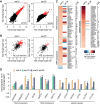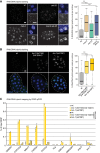Synergistic lethality between BRCA1 and H3K9me2 loss reflects satellite derepression
- PMID: 30804228
- PMCID: PMC6446544
- DOI: 10.1101/gad.322495.118
Synergistic lethality between BRCA1 and H3K9me2 loss reflects satellite derepression
Abstract
Caenorhabditis elegans has two histone H3 Lys9 methyltransferases, MET-2 (SETDB1 homolog) and SET-25 (G9a/SUV39H1 related). In worms, we found simple repeat sequences primarily marked by H3K9me2, while transposable elements and silent tissue-specific genes bear H3K9me3. RNA sequencing (RNA-seq) in histone methyltransferase (HMT) mutants shows that MET-2-mediated H3K9me2 is necessary for satellite repeat repression, while SET-25 silences a subset of transposable elements and tissue-specific genes through H3K9me3. A genome-wide synthetic lethality screen showed that RNA processing, nuclear RNA degradation, the BRCA1/BARD1 complex, and factors mediating replication stress survival are necessary for germline viability in worms lacking MET-2 but not SET-25. Unlike set-25 mutants, met-2-null worms accumulated satellite repeat transcripts, which form RNA:DNA hybrids on repetitive sequences, additively with the loss of BRCA1 or BARD1. BRCA1/BARD1-mediated H2A ubiquitination and MET-2 deposited H3K9me2 on satellite repeats are partially interdependent, suggesting both that the loss of silencing generates BRCA-recruiting DNA damage and that BRCA1 recruitment by damage helps silence repeats. The artificial induction of MSAT1 transcripts can itself trigger damage-induced germline lethality in a wild-type background, arguing that the synthetic sterility upon BRCA1/BARD1 and H3K9me2 loss is directly linked to the DNA damage provoked by unscheduled satellite repeat transcription.
Keywords: BRCA1 complex; DNA repeats; RNA:DNA hybrids; genome instability; heterochromatin; histone H3K9 methylation; satellite repeats; transcriptional silencing.
© 2019 Padeken et al.; Published by Cold Spring Harbor Laboratory Press.
Figures







Similar articles
-
Argonaute NRDE-3 and MBT domain protein LIN-61 redundantly recruit an H3K9me3 HMT to prevent embryonic lethality and transposon expression.Genes Dev. 2021 Jan 1;35(1-2):82-101. doi: 10.1101/gad.344234.120. Epub 2020 Dec 10. Genes Dev. 2021. PMID: 33303642 Free PMC article.
-
Histone H3K9 methylation is dispensable for Caenorhabditis elegans development but suppresses RNA:DNA hybrid-associated repeat instability.Nat Genet. 2016 Nov;48(11):1385-1395. doi: 10.1038/ng.3672. Epub 2016 Sep 26. Nat Genet. 2016. PMID: 27668659
-
Decoupling the downstream effects of germline nuclear RNAi reveals that H3K9me3 is dispensable for heritable RNAi and the maintenance of endogenous siRNA-mediated transcriptional silencing in Caenorhabditis elegans.Epigenetics Chromatin. 2017 Feb 15;10:6. doi: 10.1186/s13072-017-0114-8. eCollection 2017. Epigenetics Chromatin. 2017. PMID: 28228846 Free PMC article.
-
Establishment of H3K9-methylated heterochromatin and its functions in tissue differentiation and maintenance.Nat Rev Mol Cell Biol. 2022 Sep;23(9):623-640. doi: 10.1038/s41580-022-00483-w. Epub 2022 May 13. Nat Rev Mol Cell Biol. 2022. PMID: 35562425 Free PMC article. Review.
-
Repressive Chromatin in Caenorhabditis elegans: Establishment, Composition, and Function.Genetics. 2018 Feb;208(2):491-511. doi: 10.1534/genetics.117.300386. Genetics. 2018. PMID: 29378810 Free PMC article. Review.
Cited by
-
Systematic characterization of chromodomain proteins reveals an H3K9me1/2 reader regulating aging in C. elegans.Nat Commun. 2023 Mar 6;14(1):1254. doi: 10.1038/s41467-023-36898-y. Nat Commun. 2023. PMID: 36878913 Free PMC article.
-
Role of Histone Methylation in Maintenance of Genome Integrity.Genes (Basel). 2021 Jun 29;12(7):1000. doi: 10.3390/genes12071000. Genes (Basel). 2021. PMID: 34209979 Free PMC article. Review.
-
Complete loss of H3K9 methylation dissolves mouse heterochromatin organization.Nat Commun. 2021 Jul 16;12(1):4359. doi: 10.1038/s41467-021-24532-8. Nat Commun. 2021. PMID: 34272378 Free PMC article.
-
Structure-forming repeats and their impact on genome stability.Curr Opin Genet Dev. 2021 Apr;67:41-51. doi: 10.1016/j.gde.2020.10.006. Epub 2020 Dec 3. Curr Opin Genet Dev. 2021. PMID: 33279816 Free PMC article. Review.
-
Inhibition of miR-1193 leads to synthetic lethality in glioblastoma multiforme cells deficient of DNA-PKcs.Cell Death Dis. 2020 Jul 30;11(7):602. doi: 10.1038/s41419-020-02812-3. Cell Death Dis. 2020. PMID: 32732911 Free PMC article.
References
-
- Avgustinova A, Symeonidi A, Castellanos A, Urdiroz-Urricelqui U, Solé-Boldo L, Martín M, Pérez-Rodríguez I, Prats N, Lehner B, Supek F, et al. 2018. Loss of G9a preserves mutation patterns but increases chromatin accessibility, genomic instability and aggressiveness in skin tumours. Nat Cell Biol 20: 1400–1409. 10.1038/s41556-018-0233-x - DOI - PubMed
Publication types
MeSH terms
Substances
Grants and funding
LinkOut - more resources
Full Text Sources
Molecular Biology Databases
Research Materials
Miscellaneous
